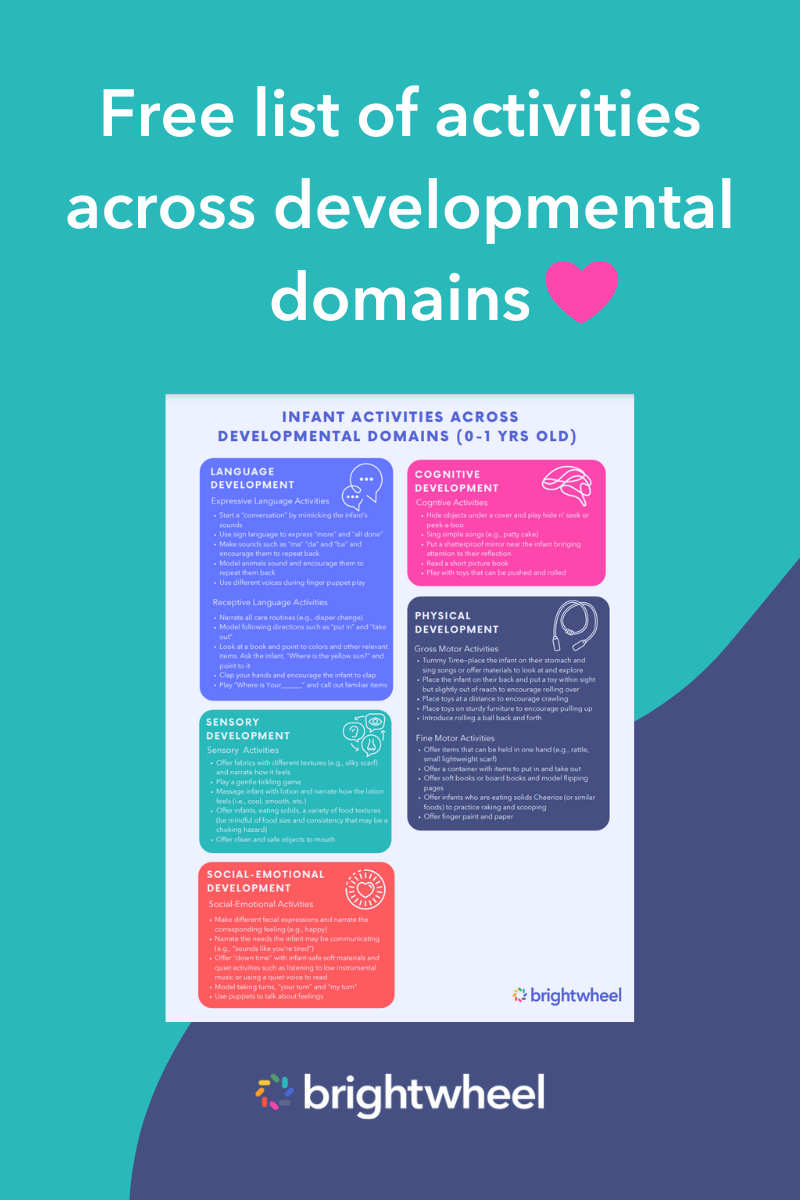
Seeing a child smile for the first time, sit up, or take their first steps are some of the most exciting moments for families and childcare providers. Since children spend so much time with their childcare providers, you play a significant role in ensuring they reach those exciting developmental milestones.
Your work may involve observing and screening the children in your care for behavioral or developmental delays with resources like the Ages and Stages Questionnaire® (ASQ).
The ASQ® is a great tool that can help screen for developmental delays in child behavior and provide resources to concerned families hoping to help their child reach their milestones.
Read on to learn more about the ASQ® screening, how to assess children's development, and what you can do to prepare yourself and your families for the ASQ® assessment.

What is developmental screening and why is it important?
Developmental screening is a process that monitors how children develop within the domains of child development (i.e. physical, cognitive, social-emotional, and language.) Developmental screening identifies children who may be at risk for health conditions or developmental delays and need additional resources and support in the classroom.
Most importantly, developmental screening can catch any delays early and provide children with the appropriate resources they need to meet important milestones. For example, an ASQ® screening in an early education setting can identify any developmental delays, learning disorders, or behavioral or social-emotional problems in the crucial time before kindergarten, providing children with access to early intervention services like speech or physical therapy.
Early childhood educators can also use the results of a developmental screening like the ASQ® screening to inform activities that can be used in the classroom and at home and meet all of their children’s needs. For example, if a child has trouble with some skills, teachers can incorporate age-appropriate activities and games that can boost children’s development and share additional learning activities that families can practice at home.
Enhance learning outcomes with brightwheel's progress report feature. Quickly document children's progress toward developmental milestones directly from the app and share progress reports instantly with families, fostering open communication and partnership.
What is the Ages and Stages Questionnaire (ASQ)®?
The Ages and Stages Questionnaire® (ASQ®) is a developmental and social-emotional screening for children from birth to six years of age. The purpose of the screening is to highlight or detect developmental delays with the help of families and early educators.
There are a few variations of the ASQ® screenings. However, this article will specifically focus on the ASQ-3® screening, which focuses on five key areas:
- Communication
- Gross motor skills
- Fine motor skills
- Problem-solving
- Personal-social development
There are 21 ASQ-3® questionnaires for children from birth to five-and-a-half years of age.
Here is how to complete the ASQ® questionnaire in six simple steps:
1. Use ASQ® Online or the ASQ® calculator to select the questionnaire that matches your children’s ages.
2. Distribute the questionnaire to your children’s families online, by mail, or in person.
3. Have your children’s families complete the questions for each key area of the questionnaire. As they take 10–15 minutes to complete the questionnaire, they'll answer a series of questions based on their daily interactions with their child. In addition, an overall section at the end of the questionnaire asks general questions about the child. If families are unsure of the answer to a question, they can partake in the activity with their child to help them answer it.
4. Once families have completed the questionnaire, they'll return it to you for scoring. Each answer is assigned a numerical value. Scores are tallied in the five developmental areas using the following point value system:
-
-
Yes = 10 points
-
Sometimes = 5 points
- Not yet = 0 points
-
Scores for questionnaires completed in person or by mail can be tallied in as little as three minutes. Online questionnaires are tallied automatically.
5. Discuss the questionnaire results with families and determine next steps such as providing resources for monitoring, further assessment, and early intervention programs, if needed.
6. Share learning activities with families that may encourage their child’s further development.
Build quality connections with families in your program with a tool like brightwheel’s communication feature. Message families directly from the brightwheel app and share important updates about their child’s progress.
Benefits of ASQ® screening
There are many benefits to using ASQ® screening in your childcare program.
Quick and easy to complete
The ASQ-3® assessment is reader-friendly and contains tips and illustrations to help educators and families assess their children quickly and accurately.
Helps your program become accredited
Using developmental screening in your childcare program is a prerequisite for receiving NAEYC accreditation or participating in a quality rating and improvement system (QRIS). The ASQ® assessment is a high-quality screening tool that can help your program become accredited and increase its QRIS rating.
Encourages participation from families
Using ASQ® screening allows your families to partner with you and your staff to observe their children during activities and assess their development. The ASQ-3® assessment includes fun, inexpensive, culturally sensitive activities that families can complete with their children at home.
Helps your staff learn more about child development
The ASQ-3® assessment provides detailed descriptions of each stage of child development and helps educators learn to identify age-appropriate milestones of healthy development. The screening system also includes training DVDs, in-person seminars, and annual training institutes that help educators at all stages of their careers understand the ASQ-3® assessment and its approach to promoting healthy development.
How to prepare for the ASQ-3® assessment
The ASQ-3® assessment can be customized to fit the needs of your children, families, and educators. Follow these steps to choose the right ASQ-3® assessment for your program and prepare your families and educators to complete the assessment.
Decide on a screening tool that is right for your organization
When choosing a screening tool for your organization, you should consider all included costs and the level of technical support that you have access to. There are several types of screening tools available, including:
- Mail-out
- Online
- Telephone interview
- Home visit
Set guidelines and goals for your program
Take time to think about the guidelines you'd like to put in place for your program, such as how often you'd like to screen and the criteria for being referred for screening. These guidelines will help you achieve the goals you’ve set for the children in your care.
Put procedures into place
After you set guidelines and goals, you'll want to implement processes and procedures for your program. Decide who will administer the screenings and when they will be administered. How will you keep track of scores and developmental progress? This plan will ensure that you have the proper documentation needed.
Receive training and train your staff
You'll want to ensure that you and your team can perform the screening accurately from start to finish. Make sure your team understands the purpose of the screening and any strategies for success, including how to speak with families about potential developmental delays.
Get families involved
This is the most crucial step. You can ensure that families are involved by opening the lines of communication when potential red flags are raised. Families often know what’s best for their children. Be sure to lean on their knowledge and address their concerns.
FAQs about the ASQ® assessment
Who uses the ASQ® assessment?
The ASQ® assessment can be used in every setting that provides care to children. Early childhood education programs, pediatric offices, physical and occupational therapists, speech-language pathologists, state and local organizations, and children’s families all use the ASQ® assessment to screen children for developmental delays and help them get the early intervention services they may need.
Where can the assessment be conducted?
You can complete the assessment in the child's home or school.
What languages are available for ASQ-3®?
The ASQ-3® is available in English, Arabic, Chinese, French, Spanish, and Vietnamese.
Does the screening only highlight developmental delays?
No, one of the main goals of the screening is to highlight developmental progress, as well as catch any developmental delays.
How can I get started with ASQ®?
Visit the ASQ® website for more information about screening tools and how to get started.
Conclusion
The ASQ-3® is a trusted screening assessment that gives you and your families invaluable insight into developmental delays that may affect your children. The assessment’s results can also help you plan resources for children who may need additional support in the classroom. Encouraging families to get involved in the screening process can help you catch children’s behaviors and responses that may not be evident in the classroom so you can achieve the most accurate results possible.
Brightwheel is the complete solution for early education providers, enabling you to streamline your center’s operations and build a stand-out reputation. Brightwheel connects the most critical aspects of running your center—including sign in and out, parent communications, tuition billing, and licensing and compliance—in one easy-to-use tool, along with providing best-in-class customer support and coaching. Brightwheel is trusted by thousands of early education centers and millions of parents. Learn more at mybrightwheel.com.

